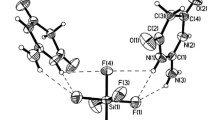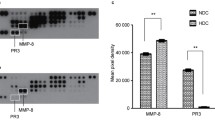Summary
Absence of precipitation of calcium phosphate salts onto tooth surfaces from human saliva, which is supersaturated with respect to calcium phosphate salts, has been attributed in part to the presence in the salivary secretions of a group of acidic proline-rich phosphoproteins (PRP). These macromolecules are considered to act by adsorbing onto dental enamel where they inhibit surface-induced precipitation of calcium phosphate salts. The inhibitory activity is known to be associated primarily with the amino-terminal region of the PRP. The aim of this study was to determine the features of the primary structure of this molecular segment responsible for inhibitory activity. The 30-residue, amino-terminal segment of PRP-3, which contains the two phosphoserines and 11 of the 13 carboxyl groups present in PRP-3, was obtained by tryptic digestion. This peptide, designated PRP-3(Tl), was treated with thermolysin to give the monophosphopeptides, Val-PSer-Gln-Glu-Asp-Val-Pro and Leu-Val-Ile-Ser-Asp-Gly-Gly-Asp-PSer-Glu-Gln, and with alkaline phosphatase to give the dephosphorylated analog, PRP-3(Tl)DP. The inhibitory activities of PRP-3(Tl) and the derived peptides, a synthetic peptide, phosphoseryl-phosphoserine (PSer-PSer), and O-phosphoserine (PSer), were determined using an assay based on inhibition of seeded precipitation of calcium phosphate. Inhibitory activities, expressed as concentrations of inhibitors required to give standard inhibitory activities, were PRP-3(Tl), 0.59 μM; PSer-PSer, 3.5 μM; the two monophosphopeptides, 29 and 32.5 μM; PRP-3(Tl)DP, 56 μM; PSer, 329 μM. These results show the importance of the simultaneous presence of two phosphoserines in these precipitation inhibitors, and the contributions made by the carboxylic groups, but they also clearly show that a major part of the inhibitory activity is related to the structure of the intact molecule.
Similar content being viewed by others
References
Hay DI, Schluckebier SK, Moreno EC (1982) Equilibrium dialysis and ultra-filtration studies of calcium and phosphate binding by human salivary proteins. Implications for salivary supersaturation with respect to calcium phosphate salts. Calcif Tissue Int 34:531–538
Lagerlof F (1983) Effect of flow rate and pH on calcium phosphate saturation in human parotid saliva. Caries Res 17:403–411
Gron P, Hay DI (1976) Inhibition of calcium phosphate precipitation by human salivary secretions. Archs Oral Biol 21:201–205
Hay DI, Gron P (1976) Inhibitors of calcium phosphate precipitation in human whole saliva. In: Stiles HM, Loesche WJ, O'Brien TC (eds) Microbial aspects of dental caries (Sp sup microbiology abstracts). Information Retrieval, Washington DC 1:143–150
Hay DI, Schlesinger DH, Moreno EC (1979) Phosphoprotein inhibitors of calcium phosphate precipitation from human salivary secretions. Inorg Persp Biol Med 2:271–285
Hay DI (1973) The isolation from human parotid saliva of a tyrosine-rich acidic peptide which exhibits high affinity for hydroxyapatite surfaces. Archs Oral Biol 18:1531–1541
Schlesinger DH, Hay DI (1977) Complete covalent structure of statherin, a tyrosine-rich acidic peptide which inhibits calcium phosphate precipitation from human parotid saliva. J Biol Chem 252:1689–1695
Oppenheim FG, Hay DI, Franzblau C (1971) Proline-rich proteins from human parotid saliva. I. Isolation and partial characterization. Biochemistry 10:4233–4238
Bennick A, Connell GE (1971) Purification and partial characterization of four proteins from human parotid saliva. Biochem J 123:455–464
Hay DI, Smith DJ, Schluckebier SK, Moreno EC (1984) Relationship between concentrations of human salivary statherin and inhibition of calcium phosphate precipitation in stimulated human parotid saliva. J Dent Res 63:857–863
Moreno EC, Varughese K, Hay DI (1979) Effect of human salivary proteins on the precipitation kinetics of calcium phosphate. Calcif Tissue Int 28:7–16
Hay DI, Oppenheim FG (1974) Isolation of a further group of proline-rich proteins from human parotid saliva. Archs Oral Biol 19:627–632
Wong RSC, Bennick A (1980) The primary structure of a salivary calcium-binding proline-rich phosphoprotein (Protein C), a possible precursor of a related salivary protein A. J Biol Chem 255:5943–5948
Schlesinger DH, Hay DI (1986) The complete covalent structure of a proline-rich phosphoprotein, PRP-2, an inhibitor of calcium phosphate crystal growth from human parotid saliva. Int J Peptide Prot Res 27:373–379
Wong RSC, Hofmann T, Bennick A (1979) The complete primary structure of a proline-rich phosphoprotein from human saliva. J Biol Chem 254:4800–4808
Schlesinger DH, Hay DI (1979) Complete primary structure of a proline-rich phosphoprotein (PRP-4), a potent inhibitor of calcium phosphate precipitation in human parotid saliva. In: Gross E, Meienhofer J (eds) Peptides: structures and biological function. Proc 6th American Peptide Symposium. Pierce Chemical Co., Rockford, IL, pp 133–136
Schlesinger DH, Hay DI (1981) Primary structure of the active tryptic fragments of human and monkey salivary anionic proline-rich proteins. Int J Peptide Protein Res 17:34–41
Aoba T, Moreno EC, Hay DI (1984) Inhibition of apatite crystal growth by the amino-terminal segment of human salivary acidic proline-rich proteins. Calcif Tissue Int 36:651–658
Moreno EC, Kresak M, Hay DI (1982) Adsorption thermodynamics of acidic proline-rich human salivary proteins onto calcium apatites. J Biol Chem 257:2981–2989
Moreno EC, Kresak M, Hay DI (1984) Adsorption of molecules of biological interest onto hydroxyapatite. Calcif Tissue Int 36:48–59
Bennick A, Cannon M, Madapallimattam G (1979) The nature of the hydroxyapatite binding site in the acidic prolinerich proteins. Biochem J 183:115–126.
Davis BJ (1964) Disc electrophoresis II. Method and application to human serum proteins. Ann NY Acad Sci 121: 404–427
Maeda N, Kim HS, Azen EA, Smithies O (1985) Differential RNA splicing and post-translational cleavages in the human salivary proline-rich protein gene system. J Biol Chem 260:11123–11130
Gron P (1973) The demonstration of a dicalcium phosphate stabiolizing factor in human saliva. Arch Oral Biol 18:1379–1383
Bjerrum N (1958) Calciumorthophosphate. Kgl danske Vidensk Selsk math fys Medd 31:1–79
Lowry OH, Lopez JA (1946) The determination of inorganic phosphate in the presence of labile phosphate esters. J Biol Chem 162:421–428
Matsubara H, Sasaki RM, Singer A, Jukes TH (1966) Specific nature of hydrolysis of insulin and tobacco mosaic virus protein by thermolysin. Archs Biochem Biophys 115:324–331
Matsubara H (1966) Observations on the specificity of thermolysin with synthetic peptides. Biochem Biophys Res Comm 24:427–430
Morihara K (1967) The specificities of various neutral and alkaline proteinases from microorganisms. Biochem Biophys Res Comm 26:656–661
Ambler RP, Meadway RJ (1968) The use of thermolysin in amino-acid sequence determination. Biochem J 108:893–895
Matsubara H (1970) Purification and assay of thermolysin. Vol. 19 In: Colowick SP, Kaplan NO (eds) Methods in enzymology. Academic Press, New York, London, pp. 642–650
Williams G, Sallis JD (1978) Structure-activity relationship of inhibitors of hydroxyapatite formation. Biochem J 184:181–184
Williams G, Sallis JD (1982) Structural factors influencing the ability of compounds to inhibit hydroxyapatite formation. Calcif Tissue Int 34:169–177
Juriaanse AC, Arends J, Ten Bosch JJ (1980) The adsorption of acidic and basic homopolypeptides to whole bovine dental enamel. J Coll Int Sci 76:212–219
Olander DS, Holtzer AJ (1968) The stability of the poly-glutamic acid alpha helix. J Am Chem Soc 90:4549–4560
Kresak M, Moreno EC, Zahradnik RT, Hay DI (1977) Adsorption of amino-acids onto hydroxyapatite. J Colloid Int Sci 59:283–292
Author information
Authors and Affiliations
Rights and permissions
About this article
Cite this article
Hay, D.I., Carlson, E.R., Schluckebier, S.K. et al. Inhibition of calcium phosphate precipitation by human salivary acidic proline-rich proteins: Structure-activity relationships. Calcif Tissue Int 40, 126–132 (1987). https://doi.org/10.1007/BF02555696
Received:
Revised:
Issue Date:
DOI: https://doi.org/10.1007/BF02555696




